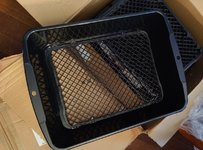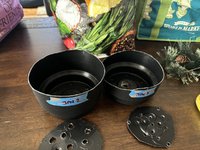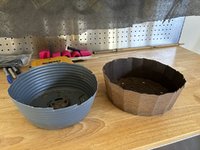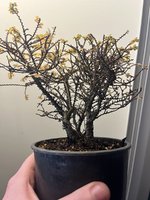What’s your latest Bonsai related purchase?
- Thread starter Mapleminx
- Start date
D
Deleted member 47471
Guest
Really nice. I even like the case. Built to last! Enjoy the Jin pliers!Another Black Friday deal came in the mail - Tian Bonsai jin pliers at 30% off.
Professional grade, 4Cr13MoV alloy steel, 225 mm length.
View attachment 520713
jerzyjerzy
Mame
I bought 20 of these sieves as training pots. They are slightly smaller than the Anderson Deep Propagation Flat, and about the same height. Also Anderson Flats are not available where I live.
Plastic is of decent quality, slightly elastic, so there is a chance the sieves will not crumble after a single season. There is a double bottom which allows to adjust the holes between 4 and 10 mm size.
And they are much more stable than a round colander.

Plastic is of decent quality, slightly elastic, so there is a chance the sieves will not crumble after a single season. There is a double bottom which allows to adjust the holes between 4 and 10 mm size.
And they are much more stable than a round colander.

D
Deleted member 47471
Guest
Very interesting concept to me. Yesterday, I spent 45 minutes in a local shop looking at various shapes of containers (including sieves) as I’m planning to laterally grow the roots in 6 of my bonsais this coming Spring.I bought 20 of these sieves as training pots. They are slightly smaller than the Anderson Deep Propagation Flat, and about the same height. Also Anderson Flats are not available where I live.
Plastic is of decent quality, slightly elastic, so there is a chance the sieves will not crumble after a single season. There is a double bottom which allows to adjust the holes between 4 and 10 mm size.
And they are much more stable than a round colander.
View attachment 520729
My hesitancy was wondering if soil would easily escape and potentially compromise the root system either from the sieves or even net pots/baskets. I made some decisions on the smaller trees but plan to get Anderson flats for the larger sized trees I plan to thicken as well.
I want to know how these work out for you because I had a similar idea yesterday lol Ok to follow you? (I’ll make a post soon and share my recent purchase and plan)
jerzyjerzy
Mame
Maiden69
Masterpiece
Where did you bought that? I have not seen anything like that available at that price online.Hokkaido Chinese elm. Couldn’t resist. Has a nice main trunk and some decent taper! 30$ Mini bonsai!
Scrogdor
Chumono
Just bought it at a local nursery in Berkeley. The actual product is from Iseli Nursery, but they only do whole sale.Where did you bought that? I have not seen anything like that available at that price online.
hardtimes
Mame
Very interesting concept to me. Yesterday, I spent 45 minutes in a local shop looking at various shapes of containers (including sieves) as I’m planning to laterally grow the roots in 6 of my bonsais this coming Spring.
My hesitancy was wondering if soil would easily escape and potentially compromise the root system either from the sieves or even net pots/baskets. I made some decisions on the smaller trees but plan to get Anderson flats for the larger sized trees I plan to thicken as well.
I want to know how these work out for you because I had a similar idea yesterday lol Ok to follow you? (I’ll make a post soon and share my recent purchase and plan)
i got these for that same reason, theyre a good size
D
Deleted member 47471
Guest
Purchased and altered containers:

Idea is to force root flare and thicken base/trunk:

My thinking is that the disc with drain holes will not allow the *majority of roots* to go directly down, but forcing them out in all directions and then allowing them down in option 1 as opposed to option 2 without a disc/suspended flooring.
Alternate containers and utilizing discs inside them (wider than other containers)

The trees to be repotted:


Overall, it is better to have more soil between the roots and the container floor (option 1 vs. 2)? Is there any risk or benefit in disc vs. no disc?

Idea is to force root flare and thicken base/trunk:

My thinking is that the disc with drain holes will not allow the *majority of roots* to go directly down, but forcing them out in all directions and then allowing them down in option 1 as opposed to option 2 without a disc/suspended flooring.
Alternate containers and utilizing discs inside them (wider than other containers)

The trees to be repotted:


Overall, it is better to have more soil between the roots and the container floor (option 1 vs. 2)? Is there any risk or benefit in disc vs. no disc?
Tentakelaertje
Omono
Not sure, but with solid, non drilled, wood there's a definite benefit of flat root growth. The downside of it is that the soil layer directly in the middle underneath the wood often remains much too dry for much activity to happen. With these disks you show in your first pic that probably won't be a problem as the holes are quite large. The benefit remains, but I wonder if it's better to have smaller holes though, so roots underneath will be cut off way earlier and start producing more wood and burl on top of the disk much quicker. That is after all the main reason to use this technique. Last thing is the chemicals in the paint and that the metal might trap a lot of heat right under the trunk. The threads about metal pots will know that better than I tho.Purchased and altered containers:
View attachment 520752
Idea is to force root flare and thicken base/trunk:
View attachment 520753
My thinking is that the disc with drain holes will not allow the *majority of roots* to go directly down, but forcing them out in all directions and then allowing them down in option 1 as opposed to option 2 without a disc/suspended flooring.
Alternate containers and utilizing discs inside them (wider than other containers)
View attachment 520754
The trees to be repotted:
View attachment 520755
View attachment 520756
Overall, it is better to have more soil between the roots and the container floor (option 1 vs. 2)? Is there any risk or benefit in disc vs. no disc?
Other question: where do you see these trees in 5 and 10 years? Because there might be techniques that suit much better.
Michigan Tree Murderer
Masterpiece
I like a nice experiment. I've seen a few different techniques but never tried applying them yet. You'll probably get more feedback/answers if you post the above in GD.Purchased and altered containers:
View attachment 520752
Idea is to force root flare and thicken base/trunk:
View attachment 520753
My thinking is that the disc with drain holes will not allow the *majority of roots* to go directly down, but forcing them out in all directions and then allowing them down in option 1 as opposed to option 2 without a disc/suspended flooring.
Alternate containers and utilizing discs inside them (wider than other containers)
View attachment 520754
The trees to be repotted:
View attachment 520755
View attachment 520756
Overall, it is better to have more soil between the roots and the container floor (option 1 vs. 2)? Is there any risk or benefit in disc vs. no disc?
19Mateo83
Masterpiece
D
Deleted member 47471
Guest
I understand most of what you are saying, but I am curious about the comments regarding metal. All containers shown for the Spring 2024 repotting (either the black ones that were cut or the wider ones that are not black) are plastic. Discs are also plastic. 5-10 years from now I want more thickness rather than height. I am still less than 1 year into Bonsai and these are my two smallest trees. I like the idea of keeping them shorter and wider. Maybe less than 90 centimeters. I suppose that could change over time, but I definitely want to learn to build nebari and thicken the base as horticulture improves.Not sure, but with solid, non drilled, wood there's a definite benefit of flat root growth. The downside of it is that the soil layer directly in the middle underneath the wood often remains much too dry for much activity to happen. With these disks you show in your first pic that probably won't be a problem as the holes are quite large. The benefit remains, but I wonder if it's better to have smaller holes though, so roots underneath will be cut off way earlier and start producing more wood and burl on top of the disk much quicker. That is after all the main reason to use this technique. Last thing is the chemicals in the paint and that the metal might trap a lot of heat right under the trunk. The threads about metal pots will know that better than I tho.
Other question: where do you see these trees in 5 and 10 years? Because there might be techniques that suit much better.
D
Deleted member 47471
Guest
Good advice, yes, I will post there also (thank you)I like a nice experiment. I've seen a few different techniques but never tried applying them yet. You'll probably get more feedback/answers if you post the above in GD.
Scorpius
Chumono
Not a fan of rakes myself. I much prefer my root hook and chopsticksI figured it was time to finally buy a root rake. I been using an aluminum chopstick and it works pretty good. I’m curious to see if I like the rake or not.
View attachment 520775
Kievnstavick
Chumono
I bought those same containers for the same reason xD. I wanted some seedling trays with a mesh bottom, but I didn't want to put in for an order from Anderson just yet. I'll either want to get a production line going for seedlings or get a group buy before I go with Anderson.
i got these for that same reason, theyre a good size
I use window screen (smaller then 1/8in) on the bottom as I am using my waste extra fines from sifting as a medium for my indoor starts. Pictured is a tray of grass for my cat (cause he is spoiled and I don't want him eating my other plants).

I figured it was time to finally buy a root rake. I been using an aluminum chopstick and it works pretty good. I’m curious to see if I like the rake or not.
View attachment 520775
I started with a root rake, but I found that I prefer using bamboo or metal chopsticks to clear the clutter. I found the rake to be too aggressive at times and it ripped roots apart rather then teasing them apart. I still need to finish my wooden root rake that 'should' be more gentle on the roots to test if I just don't like the rake.
You'll like it.I figured it was time to finally buy a root rake. I been using an aluminum chopstick and it works pretty good. I’m curious to see if I like the rake or not.
View attachment 520775
19Mateo83
Masterpiece
Broke it in tonight and I do. Actually can’t believe it took me this long to get one.You'll like it.
19Mateo83
Masterpiece
It has its uses. I tried it out tonight and it is easier to break up pot bound roots with the chopstick but it is easier to comb the roots out once they are tangle free.I bought those same containers for the same reason xD. I wanted some seedling trays with a mesh bottom, but I didn't want to put in for an order from Anderson just yet. I'll either want to get a production line going for seedlings or get a group buy before I go with Anderson.
I use window screen (smaller then 1/8in) on the bottom as I am using my waste extra fines from sifting as a medium for my indoor starts. Pictured is a tray of grass for my cat (cause he is spoiled and I don't want him eating my other plants).
View attachment 520798
I started with a root rake, but I found that I prefer using bamboo or metal chopsticks to clear the clutter. I found the rake to be too aggressive at times and it ripped roots apart rather then teasing them apart. I still need to finish my wooden root rake that 'should' be more gentle on the roots to test if I just don't like the rake.
Scrogdor
Chumono
Similar threads
- Replies
- 6
- Views
- 1K
- Replies
- 1
- Views
- 1K
- Replies
- 98
- Views
- 16K




